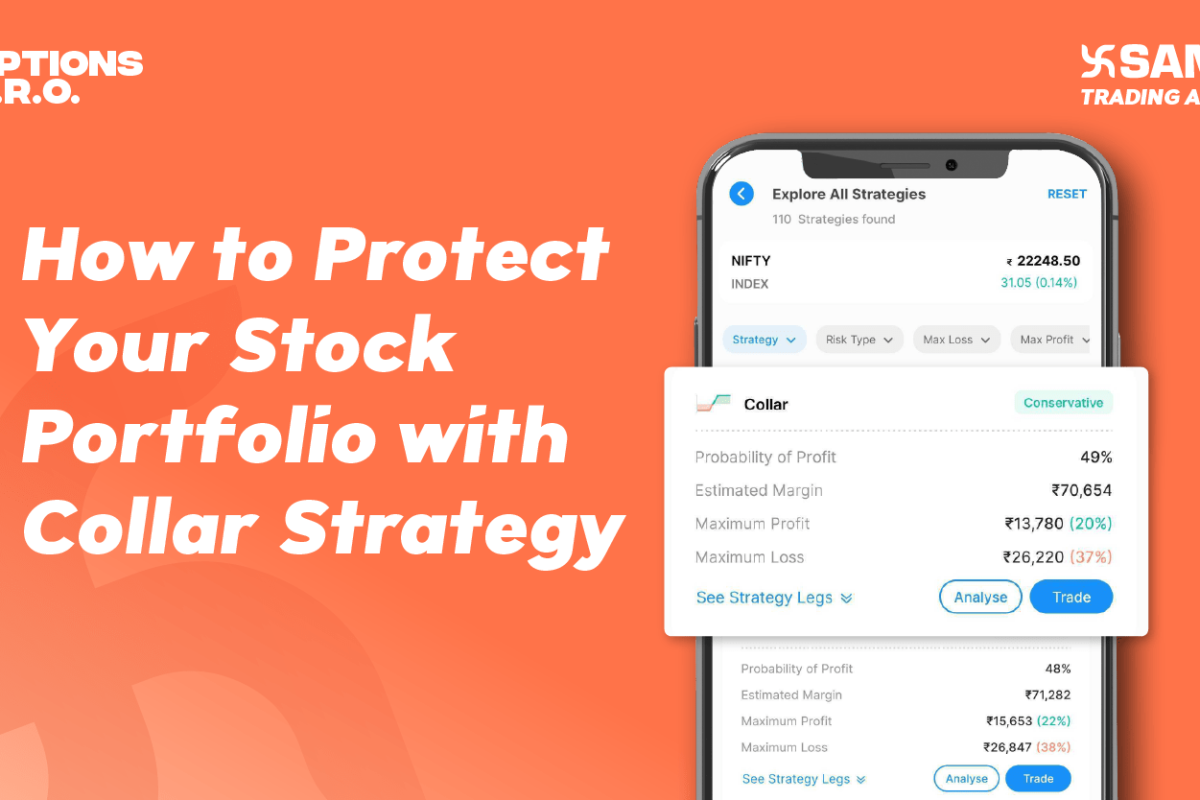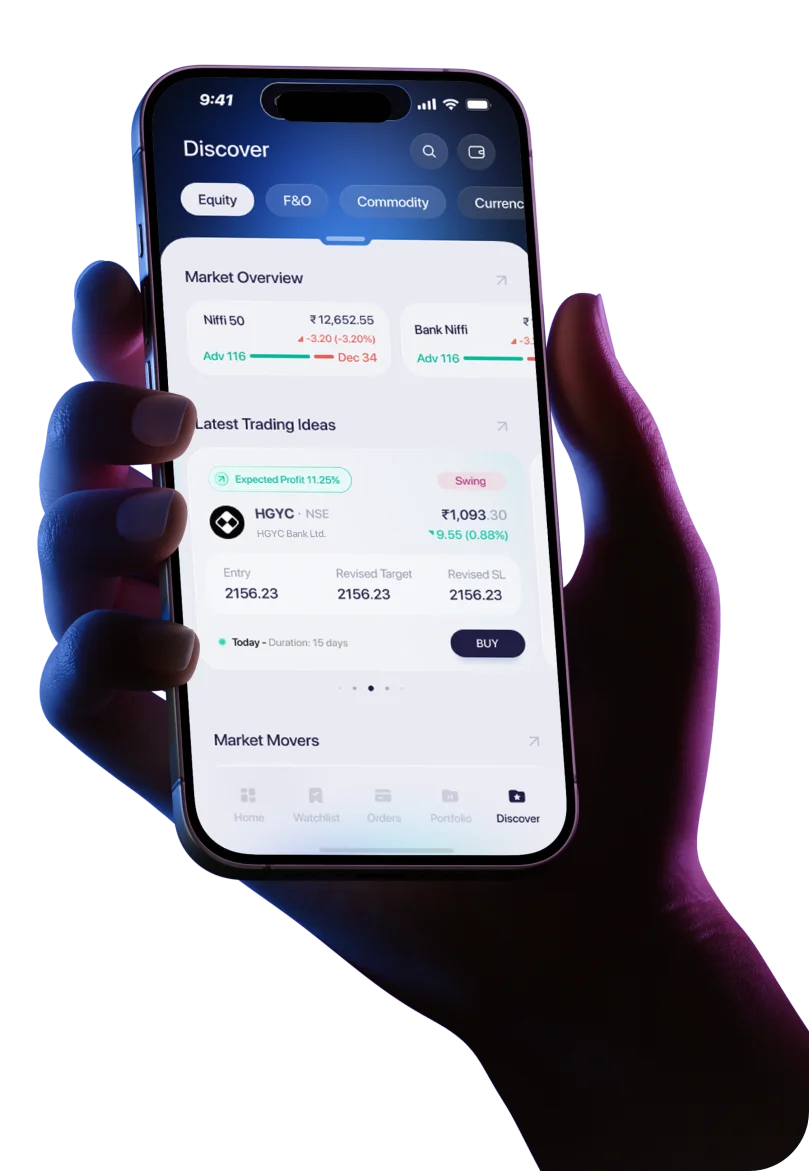Introduction
Every investor dreams of steady returns, but the Indian stock market is never free from volatility. Even fundamentally strong stocks can witness sharp declines during global sell-offs, earnings disappointments, or sudden policy changes. While diversification and stop-loss orders are common tools, they don’t always guarantee protection. What if you could insure your portfolio at a relatively low cost, while still participating in upside gains to some extent?
This is where the Collar Strategy comes in. A smart blend of a covered call and a protective put, the collar helps you lock in profits and cushion downside risks without liquidating your holdings. For Indian investors, be it retail traders, high-net-worth individuals, or long-term equity holders, this strategy can act like a shield during turbulent times.
In this guide, we’ll explain what the collar strategy is, why and how to use it, practical Indian examples, mistakes to avoid, and how you can implement it with Samco’s tools.
What Is a Collar Strategy?
At its core, a collar strategy is an options-based hedging strategy that protects your stock portfolio from steep losses while capping your profits at a certain level.
It involves three components:
- Owning the Stock – You must hold the underlying stock (e.g., Infosys shares).
- Buying a Protective Put – This acts like insurance. If the stock price falls below a certain level, the put gives you the right to sell at that strike, limiting losses.
- Selling a Covered Call – You sell a call option at a higher strike price, agreeing to sell your stock if it rises above that level. The premium earned from selling this call helps offset the cost of buying the put.
In simple terms: Long Stock + Long Put + Short Call = Collar Strategy.
This results in a “profit collar”, your upside is capped, but your downside is protected. The payoff diagram looks like a tunnel, where losses are limited below the put strike and profits are limited above the call strike. The middle range allows you to benefit from moderate price appreciation.
Why Use Collar Strategy to Protect Portfolio?
Indian investors often face a dilemma: should they book profits in volatile times or continue holding quality stocks? The collar strategy provides a middle ground.
Key reasons to use it:
- Downside Protection: By purchasing a protective put, you create a safety net for your portfolio. Even if the stock falls sharply, your loss is capped at the put strike minus the premium.
- Low-Cost Hedge: Unlike buying a put outright, selling a covered call helps fund the put premium. This makes it a cost-effective insurance method.
- Reduced Portfolio Volatility: The strategy smoothens equity returns by ensuring losses don’t spiral out of control.
- Retain Ownership: Instead of exiting your stock position (which may trigger taxes or miss long-term gains), you can hedge while holding your shares.
- Best During Volatility or Earnings Season: Stocks like Infosys, Reliance, or TCS often swing sharply post-results. A collar cushions the downside while allowing moderate gains.
For Indian investors holding large positions or long-term portfolios, the collar acts like a seatbelt in a moving car, you may not always need it, but when turbulence hits, you’ll be glad it’s there.
How Does It Work? Step-by-Step with Example (300 words)
Let’s understand with a practical Indian example:
- You own 1 lot (600 shares) of Infosys at ₹1,400.
- To protect your downside, you buy a ₹1,350 Put (monthly expiry). Premium paid = ₹20/share.
- To offset this cost, you sell a ₹1,500 Call (monthly expiry). Premium received = ₹22/share.
Outcome Scenarios:
- If Infosys falls to ₹1,300:
- Your stock loses ₹100 (₹1,400–₹1,300).
- But your ₹1,350 Put gains ₹50 (₹1,350–₹1,300).
- Net Loss ≈ ₹50/share (capped).
- If Infosys rises to ₹1,600:
- Your stock gains ₹200.
- But your ₹1,500 Call obligates you to sell at ₹1,500.
- Net Profit ≈ ₹100/share (capped).
- If Infosys stays around ₹1,400–₹1,500:
- Stock remains stable.
- Put expires worthless (loss ₹20).
- Call premium earned offsets put cost (gain ₹22).
- Net = small profit + peace of mind.
Summary:
- Max Profit: Limited to difference between call strike (₹1,500) and buy price (₹1,400) + net premium.
- Max Loss: Limited to difference between stock price (₹1,400) and put strike (₹1,350) – net premium.
- Breakeven: Stock price adjusted for net premium.
This structured hedge ensures you never face unlimited losses, while still allowing controlled gains.
Collar Strategy vs Protective Put & Covered Call
Strategy | Components | Upside Potential | Downside Protection | Cost Implication | Best Use Case |
|---|---|---|---|---|---|
Protective Put | Long Stock + Buy Put | Unlimited | Strong (till put strike) | Expensive (premium cost) | For aggressive hedging |
Covered Call | Long Stock + Sell Call | Limited (till call strike) | None | Generates premium income | For sideways/flat markets |
Collar | Long Stock + Buy Put + Sell Call | Limited (till call strike) | Strong (till put strike) | Low/Zero (premium offset) | Balanced approach for volatile markets |
The collar provides a sweet spot by balancing the best of both worlds: downside protection at minimal cost while retaining moderate upside.
Best Situations to Use a Collar Strategy (150 words)
The collar strategy is particularly effective in the following conditions:
- Sitting on Significant Profits: If you bought Reliance at ₹2,200 and it’s now at ₹2,700, a collar protects your profits without selling.
- Before Earnings Announcements: Stocks like TCS or Infosys often swing sharply post-results. Collars safeguard against negative surprises.
- During High Volatility: When India VIX spikes, collars ensure your portfolio isn’t exposed to steep drawdowns.
- For Long-Term Investors: Instead of exiting quality holdings (which could trigger long-term capital gains tax), you can hedge and hold.
- Portfolio Hedge for HNIs: High-net-worth investors holding large stock positions can use collars to preserve wealth during uncertain markets.
Benefits and Limitations
Benefits:
- Limits downside risk without exiting stocks.
- Low-cost due to call premium offset.
- Offers peace of mind during uncertain markets.
- Ideal for investors unwilling to time the market.
Limitations:
- Upside capped beyond call strike.
- Requires options knowledge and monitoring.
- Liquidity constraints in some Indian stock options.
- Strike selection crucial – too close reduces benefits, too far may increase cost.
Case Study: How Collar Strategy Saved a Portfolio
March 2020 Market Crash Example:
Consider an investor holding HDFC Bank at ₹1,200 in February 2020. With fears of COVID-19, he applied a collar:
- Bought a ₹1,150 Put (premium ₹25).
- Sold a ₹1,300 Call (premium ₹28).
By March 2020, the stock crashed to ₹800.
- Without hedge: Loss = ₹400/share.
- With hedge: Loss capped near ₹75/share (₹1,200–₹1,150 – net premium).
While upside was capped at ₹1,300, the strategy saved nearly ₹325/share, cushioning the portfolio during a historic meltdown.
A similar application during Jan 2024 volatility (HDFC merger news) would have worked the same way. This demonstrates the collar’s ability to act as portfolio insurance during unpredictable downturns.
Common Mistakes and How to Avoid Them (150 words)
- Choosing Wrong Strikes: Too close strikes limit profitability, too far makes hedge costly.
- Selling Call Too Close to CMP: Limits your upside prematurely. Better to pick slightly OTM calls.
- Ignoring Expiry Selection: Monthly expiry is more liquid than weekly for certain stocks.
- Not Monitoring Position: Adjust strikes if stock moves sharply before expiry.
- Using Illiquid Stocks: Always check option chain liquidity on NSE before executing.
Avoiding these mistakes ensures collars remain effective and cost-efficient.
FAQs
- Can I apply a collar without owning the stock?
No, you must own the stock since you’re selling a covered call. - Can I use it on indices like NIFTY or BANKNIFTY?
Yes, collars can be applied to index futures/options as a portfolio hedge. - What if the stock gaps up?
Your upside is capped at the call strike; you may have to sell at that level. - What if the stock gaps down?
Your put ensures losses are capped beyond the strike price. - Is it suitable for all investors?
Best for moderate to conservative investors seeking protection, not aggressive traders.
Conclusion & Call-to-Action (100 words)
The collar strategy offers Indian investors a disciplined way to protect their stock portfolios from sharp declines while retaining controlled upside. By combining a protective put with a covered call, you create a cost-effective hedge that acts as portfolio insurance. Whether you’re an HNI holding large positions or a retail investor sitting on strong gains, collars help you navigate volatility with confidence.
Samco’s Option Strategy Builder and Option Greeks Calculator make it easier to implement collars effectively. Try the collar strategy today and safeguard your portfolio while continuing to participate in India’s long-term growth story.




 Easy & quick
Easy & quick
Leave A Comment?